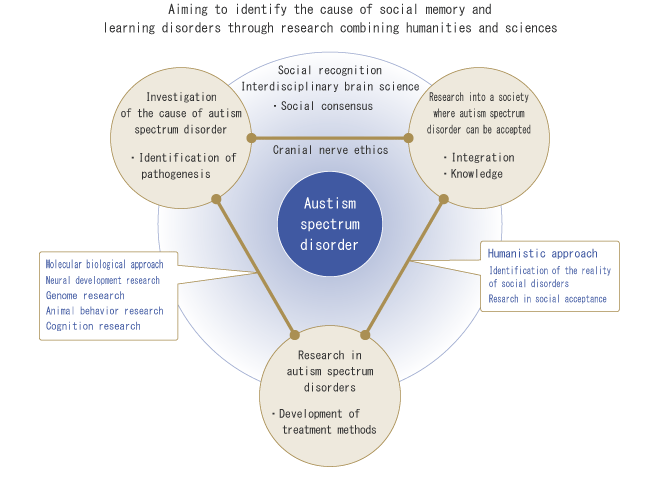Innovative brain science for development, learning and memory and their disorders:
The second stage of the university-wide initiative in integrated humanities and sciences
Research Center for Child Mental Development
Professor Haruhiro Higashida
Clarifying mental development and its disorders through research into treatment of autism spectrum disorders
The ultimate aim of clarifying the action of the human mind, or neuropsychiatric activity, is to understand how people work.
Clarifying the action of the human mind, or neuropsychiatric activity is the ultimate aim for understanding how people work. However, the process by which social learning and memory takes place and what sorts of interactions are involved is still under investigation. Therefore we are pursuing research into the development of the mind, learning, social memory and their disorders, by understanding changes at the molecular level from a biological viewpoint.
Analyzing human neuropsychiatric activity at the molecular level
The activities of our research group are focused on the Kanazawa University Research Center for Child Mental Development. We have three main research themes. The first is finding the genes related to the communication (social memory) disorder which is a symptom of childhood autism.
One finding of our research is that the hormone oxytocin which gives rise to attachment and confidence is deeply related to autism spectrum disorders.
Oxytocin functions to increase the sociability required for life. We discovered that oxytocin affects the pathogenic mechanism of the communication (social memory) disorder, which is a symptom of autism spectrum disorders. As a result of this research finding, we are currently pursuing research into treatment in response to overtures from families of children with autism.
The second theme is analysis of memory using modified model mice. The third is research into development and social memory disorders, using imaging technologies for measuring the state of the brain neuronal activity and brain blood flow. These technologies include optical topography and magnetoencephalograph (MEG).
These research themes are characterized by linkage of the humanities and sciences to addressing a novel field of brain research in a general way. The Kanazawa University Graduate School has established a research system involving the school, with the full-time participation of 30 to 40 members from the Graduate Schools of Medical Science, Natural Science and Technology and Human and Socio-Environmental Studies. In future, we aim to clarify the molecular functions that bring about disorders, making our findings available to society and carrying out research into treatment of childhood autism smoothly.
Currently, we are working to establish our research to date as a new academic field focused on clarifying the biological mechanisms behind the relationship between development, learning, memory and their disorders. We aim to develop the school as a global center with a long term strategy. We also have a cooperative relationship with the Program for Young Researcher Overseas Visits of the Japan Society for The Promotion of Science (JSPS), and we emphasize the development of young researchers.
Linking a variety of research projects and applying the findings in society
Many research projects concerning learning and social memory are being undertaken in Japan and overseas, but there are few examples of research in brain science targeting children with slight developmental disabilities, making it very unique research. In addition, we are cooperating with several graduate schools including Osaka University, Hamamatsu University School of Medicine, Chiba University and Fukui University conducting research and education as the Osak University United Graduate School of Child Development.
We are also conducting research and development of next generation brain function measuring instruments combining optical topography and magnetoencephalography (MEG). Using this measuring instrument, we aim to carry out quantitative analysis by recording the brain development, learning and social memory of infants and young children, as well as disorders by measuring changes in high order brain functions. This research and development is linked to the Hokuriku Innovation Cluster for Health Science and its successor project conducted by Ishikawa and Toyama Prefectures adopted as part of the Ministry of Education, Culture, Sports, Science and Technology's Knowledge Cluster Formation Project (Stage II). It is positioned as rare research.
Furthermore, we have established a mutual support organization with the research projects supported by the Research Institute of Science and Technology for Society (RISTEX) which promotes research and development towards solving specific social issues. In addition, we have newly obtained a sizable grant for basic and clinical researches of autism spectrum disorders from the Strategic Research Program for Brain Sciences of Ministry of Education, Culture, Sports, Science and Technology, Japan. In this program, we focus on how oxytocin functions and is secreted in the brain and on determination of efficacy of oxytocin to autistic patients, and on early diagnosis of autism spectrum disorder by MEG. We also periodically hold domestic conferences such as the Summit of Child Mind Research Groups for addressing clarification of the causes of childhood autism, treatment and integration, as well as international conferences such as Asia NAD, with aim of promoting rapid developments in research.





